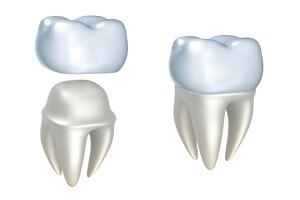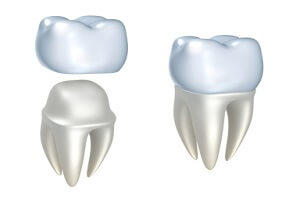Dental crowns – problems and solutions
 The last step in the tooth restoration procedure is dental crowns installation yet if inappropriately installed may be a source of pain, sensitivity or some complications. If you struggle with some inconveniences regarding dental crown abroad contact immediately your dentist. In the meantime, here you may find additional information about common issues and solutions connected with dental crowns.
The last step in the tooth restoration procedure is dental crowns installation yet if inappropriately installed may be a source of pain, sensitivity or some complications. If you struggle with some inconveniences regarding dental crown abroad contact immediately your dentist. In the meantime, here you may find additional information about common issues and solutions connected with dental crowns.
Typical problems with the dental crowns
Sensitivity to hot and cold
After crown being installed you may experience that the tooth is sensitive especially at the edge in the area of the gum line. It is mainly due to the trimming of enamel which is a part of the crowning procedure and also when the dentin underneath is exposed. In case the crown does not cover fully the teeth, even on a tiny scale, it is possible for dentin surface to be sensitive when exposed.
Yet, the good news is that you have two solutions to this issue even without removing the tooth cap. The first option is to apply toothpaste especially designed for sensitive teeth or you may contact your surgeon so that he will protect the crowned tooth where the small dentin area is exposed to temperature changes.
General tooth pain
Inflammation may occur in the area of a crowned tooth?™s pulp by the trauma caused by trimming of the tooth when a dental crown installation was performed. Generally, swelling cedes after some time and the pulp heals on its own. For the time being, you may apply over-the-counter non-steroidal anti-inflammatory (NSAID) medication to cushion the pain and inflammation.
In case?of a toothache does not cede after a couple of days despite taking NSAIDs, a root canal treatment may be required to relieve pain.
Gum tissue pain
In order to stay clear of thermal sensitivity, crowns normally end just right after or below the gum line. That is why there is no problem with gums to be roughed up at the time of trimming the tooth, taking impressions and fitting the crown.
Usually, the pain in gum lasts a few days after the inflammation subsides. In order to accelerate the healing process, you may take NSAIDs and rinse with warm salt water even three times a day.
Nerve problems
In each tooth a soft core called pulp is present and this is the place where nerves are located. When a crown is installed to restore a damaged or decayed tooth in some cases it may disturb nerves. You may feel some discomfort like small tenderness which may result from biting down or exposure to hot and cold temperatures. After having the crown installed you may experience some nerves problems or it may happen even several months after the procedure. ?Frequently, root canal treatment is a good solution for this issue and another crown installation.
Cracked root
If a crowned tooth is subjected to pressure, it may crack. Frequently, tooth crown installation is a good solution for cracked teeth yet the root is out of crown?™s reach. In case the root is cracked, the one option left is to tooth extraction.
Bite problems with dental crowns
When the dentist fits your crown he checks how the crown is connected with the rest teeth before cementing it into its proper position. Although paying attention to detail, you may see that the crown is not exactly the same shape as the numbness cedes. ?At first, it may cause annoyance but after you put too much pressure on your teeth repeatedly it may be injured and start to hurt. Also, an infection may be developed under the crown even a few months or years after their installation. Therefore, inflammation and the misaligned bite may occur.
When a crown is improperly shaped it may be a source of bite issues but a solution for this is to make an appointment with the dentist to simply reshape it. If there is an infection, a root canal a new crown is required.
Tips how to avoid problems
Check the colour
Before a permanent crown is installed first the dentist will fit the colour of a crown to your teeth just to make sure that your smile will look natural. ?A professional dentist will let you be the one who will give a consent to your treatment plan and approve or disapprove recommended options. The best way to do it is to look in the mirror at your mouth and the areas surrounding the teeth to make sure that crowns are the same hue as your teeth. If something will not come up to your expectations, do not be afraid and tell your dentist about your concerns. It is you who should be satisfied with the results. Moreover, to make sure that everything is perfect, check the colour in natural light as artificial light may be too bright or confusing. The best way is to go outdoors to see how your new smile will look like in natural light.
Check the shape
Make sure that the shape of your permanent crown is appropriate. A perfectly installed crown will make contact with the teeth on each side, therefore, food should not be stuck in the gaps whereas a crown which is not made properly may make food lodged between teeth. Moreover, if crowns are too big they may cause injury to the jaw if they contact with the teeth opposite of it. As a result, this injury may be a source of painful pulpitis or inflammation of the nerve.
Avoid certain foods
When you temporary crown was installed try to avoid certain types of food, for example, hard or sticky ones. These are for instance raw vegetables, hard candies and mints which may be responsible for breaking a crown. Other examples of hard foods are caramel, taffy or even chewing gum.
Maintain proper oral hygiene
Dental crowns have one disadvantage: the tooth under the crown may sometimes start to decay but fortunately, you can avoid this by maintaining proper oral hygiene which includes brushing and flossing daily.
- At least two times a day brush your teeth yet there is a possibility for plaque to appear, also a problem with gum after dental crown like a disease on and around the crown may happen.
- Flossing is one of the most important oral hygiene practice that you should pay attention to. Try to floss side to side rather up and down. In simple words, thread the floss between your teeth yet do not lift the floss back out in the same manner you put it between your teeth, just pull it out through the gap in your teeth. This procedure helps you not to lift the crown out together with the floss.
- Also, oral irrigator is useful while flossing which may be helpful for massaging the gums.
- You should visit your dentist regularly to make sure that in case dental issues appear they may be treated immediately.
- In case plaque and tartar accumulated around a dental crown may become a source of irritation and inflammation of surrounding gums. When gum inflammation is not treated straight away it may bring about gingivitis or periodontitis, which is manifested by loosening of teeth as a consequence of attachment loss.
After cheap dental crown installation, you may feel some discomfort or even pain right after the procedure. It may range from a general tooth and nerve pain, dental crown sensitivity to hot and cold, cracked root or other bite issues.In order to avoid such inconveniences before the dentist installs a crown check properly the colour and shape of a crown, also avoid hard foods and maintain proper oral hygiene.
For more information about a dental crown in Poland contact advisors from Dental Travel Poland and if you have any questions, they will be glad to be of your assistance.
- Dental veneers procedure step by step - October 5, 2018
- Dental Veneers – advantages and disadvantages - October 5, 2018
- Dental crowns vs dental fillings - April 6, 2018

 Posted by Marek in
Posted by Marek in 














